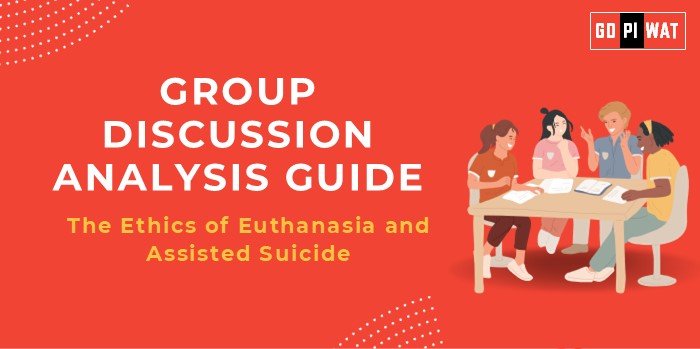📋 Group Discussion (GD) Analysis Guide: The Ethics of Euthanasia and Assisted Suicide for Terminally Ill Patients
🌐 Introduction to the Topic
Context Setting:
“The debate over euthanasia and assisted suicide is one of the most ethically and emotionally charged issues in modern medical ethics, intersecting personal autonomy and societal values.”
Background:
Euthanasia refers to intentionally ending a life to relieve pain and suffering. Assisted suicide involves providing the means for a patient to end their own life. Both practices are increasingly discussed globally due to aging populations and advances in medicine.
📊 Quick Facts and Key Statistics
- 📜 Legal Status: Legal in countries like Belgium, the Netherlands, and Canada; prohibited in most countries.
- 📊 Public Opinion: Surveys indicate 60-70% support euthanasia in some Western nations, while opinions vary in conservative societies.
- 🌍 Global Impact: Around 10,000 cases annually in jurisdictions where euthanasia is legal.
- 🏥 Medical Advancements: Palliative care improvements have reduced but not eliminated demands for euthanasia.
- 👵 Demographics: Most requests come from terminally ill cancer patients aged 50+.
🧩 Stakeholders and Their Roles
- 🏛️ Governments: Create legislation, monitor practices, and establish legal safeguards.
- 🩺 Medical Practitioners: Evaluate patient requests and administer euthanasia ethically and legally.
- 👨👩👧👦 Patients and Families: Seek autonomy in end-of-life decisions or struggle with moral dilemmas.
- ✝️ Religious Organizations: Advocate for or against practices based on theological perspectives.
- 📚 Ethicists and Advocacy Groups: Analyze societal implications and campaign for reforms or prohibitions.
🏆 Achievements and Challenges
✨ Achievements:
- ✔️ Respect for Autonomy: Countries with legalized euthanasia allow individuals to make end-of-life decisions.
- ✔️ Pain Alleviation: Offers relief from unbearable suffering where palliative care is insufficient.
- ✔️ Legal Safeguards: Protocols in countries like the Netherlands ensure transparency and prevent abuse.
- ✔️ Global Conversations: Encourages debates on improving palliative care and patient rights.
⚠️ Challenges:
- ❌ Ethical Concerns: Fear of normalizing death as a solution undermines the sanctity of life.
- ❌ Slippery Slope: Concerns about extending euthanasia to non-terminal cases, as seen in Belgium.
- ❌ Cultural Resistance: Strong opposition in countries with religious or traditional values.
🌎 Global Comparisons:
- 🇧🇪 Belgium: Expanding scope to minors and non-terminal cases stirs controversy.
- 🇯🇵 Japan: Focuses on palliative care rather than euthanasia.
- 🇺🇸 Oregon, USA: Shows controlled and limited use of assisted suicide under strict laws.
💬 Structured Arguments for Discussion
- Supporting Stance: “Euthanasia respects personal autonomy and provides dignity in death, especially when suffering is intractable.”
- Opposing Stance: “Legalizing euthanasia risks abuse, weakens societal commitment to care, and undermines ethical medical practices.”
- Balanced Perspective: “While euthanasia offers dignity and autonomy, ensuring ethical safeguards and robust palliative care is paramount.”
📚 Effective Discussion Approaches
Opening Approaches:
- 📊 Start with a Statistic: “Over 70% of citizens in Belgium support euthanasia, highlighting its societal acceptance.”
- 💭 Moral Query: “Can the right to die ever outweigh the duty to preserve life?”
- 📖 Reference a Case Study: “The Oregon Death with Dignity Act has handled over 3,000 requests since 1997 with minimal controversies.”
Counter-Argument Handling:
- ✔️ Counter Autonomy Arguments: Highlight concerns about coercion and vulnerable groups.
- ✔️ Address Slippery Slope Fears: Cite strict legal frameworks and evidence from existing systems.
📈 Strategic Analysis of Strengths and Weaknesses
- ✔️ Strengths: Autonomy, pain relief, cost reduction in terminal care.
- ❌ Weaknesses: Ethical conflicts, potential abuse, societal mistrust.
- 💡 Opportunities: Improve palliative care, expand ethical dialogue, foster societal empathy.
- ⚠️ Threats: Misuse, erosion of trust in healthcare, cultural backlash.
🏫 Connecting with B-School Applications
Real-World Applications:
- 🌟 Ethical decision-making frameworks for leadership.
- 📚 Policy implications in healthcare management.
Sample Interview Questions:
- ❓ “What are the implications of legalizing euthanasia for healthcare ethics?”
- ❓ “Discuss how cultural values shape end-of-life decisions globally.”
Insights for Students:
- 💼 Understand cross-cultural ethical perspectives.
- 📊 Explore how policy decisions affect vulnerable populations.


